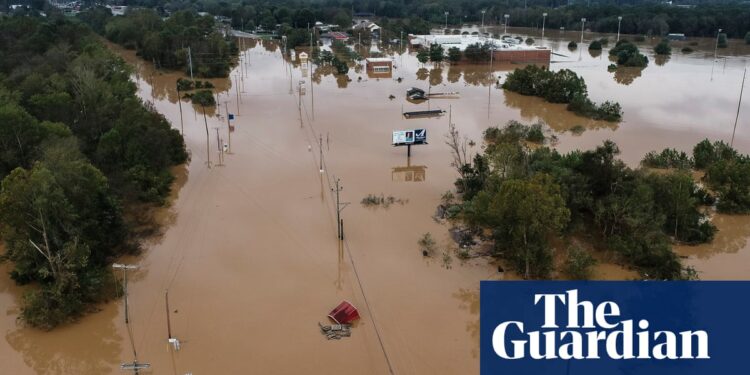The head of the US disaster relief agency has called Hurricane Helene, which has killed nearly 70 people so far, a “true multi-state event” that caused “significant infrastructure damage” and had been made worse because of global heating.
The storm killed at least 69 people, according to state and local officials in South Carolina, Florida, Georgia, North Carolina and Virginia. Officials feared still more bodies would be discovered.
“This is going to be a really complicated recovery in each of the five states” of Florida, Georgia, North Carolina, South Carolina and Tennessee, the Fema administrator, Deanne Criswell, said.
She noted that a 15ft storm surge hit Florida’s Taylor county, where Helene came ashore as a category 4 hurricane late Thursday with winds of 140mph (225km/h), and pointed out that areas of western North Carolina, where search and rescue operations are continuing, recorded 29in (74cm) of rain when the storm stalled over the region.
“This is historic flooding up in North Carolina,” Criswell told the CBS show Face the Nation on Sunday. “I don’t know that anybody could be fully prepared for the amount of flooding and landslides they are having right now.”
Kamala Harris said the Joe Biden administration had approved emergency declarations for Alabama, Florida, Georgia, North Carolina, South Carolina and Tennessee, “making resources and funding available to maximize our coordinated response efforts at the local, state, and federal levels”.
The White House said on Sunday that Biden intends to travel this week to communities impacted by Hurricane Helene as soon as it will not disrupt the emergency response.
Biden spoke with Georgia Governor Brian Kemp and North Carolina Governor Roy Cooper on Sunday evening to get updates on response and recovery efforts, and to promise continued support to impacted communities.
As many as 1,000 people remain unaccounted for in Buncombe county in the Appalachian mountains where the hurricane caused catastrophic flooding and mudslides in the Asheville region, cutting off most communication and making the roads impassable.
At least 11 people are dead in North Carolina, Cooper’s office said in an update on Sunday “Tragically we know there will be more,” Cooper said. “Even as the rain and winds have subsided, the challenge for people there increases. People are desperate for help.”
At least 23 are dead in South Carolina, including two firefighters. In Georgia, at least 17 people have died, two of them killed by a tornado in Alamo, according to a spokesperson for Kemp.
Kemp said on Saturday that it “looks like a bomb went off” after viewing splintered homes and debris-covered highways from the air.
Heavy rain nearly collapsed the Nolichucky Dam in Greeneville, Tennessee, which the National Weather Service called a “particularly dangerous situation”, as it urged at least 100,000 residents in the area to “seek higher ground now!”
In rural Unicoi county in east Tennessee, dozens of patients and staff were plucked by helicopter from a hospital rooftop on Friday. At least 11 people have died in Florida, according to Governor Ron DeSantis.
“If you had told me there was going to be 15ft to 18ft of storm surge, even with the best efforts, I would have assumed we would have had multiple fatalities,” DeSantis said.
Among the 11 confirmed deaths in Florida were nine people who drowned in their homes in a mandatory evacuation area on the Gulf coast in Pinellas county, where St Petersburg is located, Sheriff Bob Gualtieri said.
One person died in Virginia, in a storm-related tree fall and building collapse.
In Buncombe county, North Carolina, which includes the city of Asheville, more than 60 people were unaccounted for Saturday evening and more than 150 search and rescue operations were under way.
“To say this caught us off-guard would be an understatement,” said Quentin Miller, the Buncombe county sheriff.
Miller announced on Sunday that in addition to 10 people who had been killed in Buncombe county, about 1,000 remained unaccounted for.
The county manager, Avril Pinder, called the storm “Buncombe county’s own Hurricane Katrina”, and officials said communication systems have been disrupted, with no cellphone service expected in the region for at least “several days”.
To the east in McDowell county, the emergency center was inundated with 911 calls, many of which involved patients “entrapped with severe trauma, running out of oxygen or essential medical supplies”.
Nearly 400 roads are closed in the state and access to clean drinking water has been limited. Fifty boil water advisories are in effect across western communities.
“Water is a big concern,” Criswell said, saying Fema had sent in bottled supplies, dispatched the army corps of engineers to get water treatment plants functioning and sent Starlink satellite receivers to help restore communications.
The devastation, Criswell said, was linked to the climate emergency. “This storm took a while to develop, but once it did it intensified very rapidly – and that’s because of the warm waters in the Gulf that’s creating more storms that are reaching this major category level.”
The conditions, she said, were creating greater amounts of storm surge in the coastal areas and increased rainfall as the storms moved north.
“In the past, damage from hurricanes was primarily wind damage, but now we’re seeing so much more water damage and that is a result of the warm waters which is a result of climate change,” Criswell told CBS.







